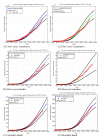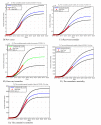Modeling and forecasting trend of COVID-19 epidemic in Iran until May 13, 2020
- PMID: 32617266
- PMCID: PMC7320984
- DOI: 10.34171/mjiri.34.27
Modeling and forecasting trend of COVID-19 epidemic in Iran until May 13, 2020
Abstract
Background: COVID-19 is a new disease and precise data are not available about this illness in Iran and in the world. Thus, this study aimed to determine the epidemic trend and prediction of COVID-19 in Iran. Methods: This was a secondary data analysis and modeling study. The daily reports of definitive COVID-19 patients released by Iran Ministry of Health and Medical Education were used in this study. Epidemic projection models of Gompertz, von Bertalanffy, and least squared error (LSE) with percentage error were used to predict the number of hospitalization cases from April 3, 2020 until May 13, 2020. Results: The prediction of the number of patients on April 3, 2020 by von Bertalanffy, Gompertz, and LSE, with 95% confidence interval (CI), were estimated at 44 200 (39 208-53 809), 47 500 (38 907-52 640), and 48 000 (40 000-57 560), respectively. The number of deceased COVID-19 patients was also estimated to be 3100 (2633-3717) individuals by the von Bertalanffy model, 3700 (2900-4310) by Gompertz's model, and 3850 (3200-4580) by LSE. Making predictions about the flat epidemic curve and number of patients based on Gompertz model, will project 67 000 (61 500-87 000) cases. Based on Gompertz and von models, 7900 (6200- 9300) and 4620 (3930- 5550) deaths will occur from May 13 to June 1, 2020, respectively, and then the curve will flatten. Conclusion: In this study, estimations were made based on severely ill patients who were in need of hospitalization. If enforcement and public behavior interventions continue with current trends, the COVID-19 epidemic will be flat from May 13 until July, 2020 in Iran.
Keywords: COVID-19; Coronavirus; Epidemiology; Modeling; Prediction.
© 2020 Iran University of Medical Sciences.
References
LinkOut - more resources
Full Text Sources
Miscellaneous




